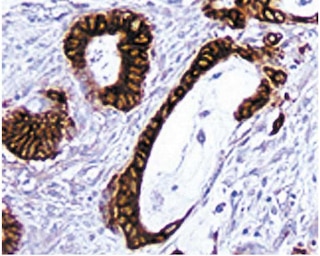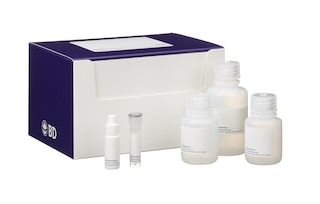Old Browser
This page has been recently translated and is available in French now.
Looks like you're visiting us from {countryName}.
Would you like to stay on the current country site or be switched to your country?




Immunohistochemical staining of CD90+ cells. Frozen section of normal human tonsil was reacted with the 5E10 antibody. Cells positive for CD90 can be identified by the brown labeling of their cell membranes. Amplification 20X.


BD Pharmingen™ Purified Mouse Anti-Human CD90

Purified Mouse Anti-Human CD90
Regulatory Status Legend
Any use of products other than the permitted use without the express written authorization of Becton, Dickinson and Company is strictly prohibited.
Preparation And Storage
Recommended Assay Procedures
Immunohistochemistry: The 5E10 clone reactive against human CD90 is recommended to test for immunohistochemical staining of acetone-fixed frozen sections. Tissues tested were human spleen and tonsil. The antibody stains endothelial cells, haematopoitic cells, stem cells and T cell precursors. The isotype control recommended for use with this antibody is purified mouse IgG1 (Cat. No. 550878). For optimal indirect immunohistochemical staining, the 5E10 antibody should be titrated (1:10 to 1:50 dilution) and visualized via a three-step staining procedure in combination with polyclonal, biotin conjugated anti-mouse Igs (multiple adsorbed) (Cat. No. 550337) as the secondary antibody and Streptavidin-HRP (Cat. No. 550946) together with the DAB detection system (Cat. No. 550880). A detailed protocol of the immunohistochemical procedure is available on our website at www.bdbiosciences.com/support/resources. The clone 5E10 is not recommended for formalin-fixed paraffin embedded sections.
Product Notices
- Since applications vary, each investigator should titrate the reagent to obtain optimal results.
- Source of all serum proteins is from USDA inspected abattoirs located in the United States.
- Caution: Sodium azide yields highly toxic hydrazoic acid under acidic conditions. Dilute azide compounds in running water before discarding to avoid accumulation of potentially explosive deposits in plumbing.
- An isotype control should be used at the same concentration as the antibody of interest.
- This antibody has been developed for the immunohistochemistry application. However, a routine immunohistochemistry test is not performed on every lot. Researchers are encouraged to titrate the reagent for optimal performance.
- Please refer to www.bdbiosciences.com/us/s/resources for technical protocols.
Companion Products






The 5E10 monoclonal antibody specifically binds to human CD90 which is also known as Thy-1. CD90 is a 25-35 kDa glycophosphatidylinositol-anchored membrane glycoprotein of the Ig superfamily that is expressed on 1-4% of human fetal liver cells, cord blood cells, and bone marrow cells. The anti-CD90 antibody binds to a subset of immature CD34+ cells and a distinct subset of mature CD34- cells that are CD3+CD4+. The CD90+CD34+ population is highly enriched for cells capable of long-term culture. The anti-CD90 antibody is useful for enriching high proliferative potential colony-forming cells (HIPP-CFC) that are primative progenitor cells.
Development References (5)
-
Baum CM, Weissman IL, Tsukamoto AS, Buckle AM, Peault B. Isolation of a candidate human hematopoietic stem-cell population. Proc Natl Acad Sci U S A. 1992; 89(7):2804-2808. (Biology). View Reference
-
Craig W, Kay R, Cutler RL, Lansdorp PM. Expression of Thy-1 on human hematopoietic progenitor cells. J Exp Med. 1993; 177(5):1331-1342. (Biology). View Reference
-
Knapp W. W. Knapp .. et al., ed. Leucocyte typing IV : white cell differentiation antigens. Oxford New York: Oxford University Press; 1989:1-1182.
-
Lansdorp PM, Thomas TE. AP Gee, ed. Bone Marrow Processing and Purging. Boca Raton FL: CRC Press; 1991.
-
Schlossman SF. Stuart F. Schlossman .. et al., ed. Leucocyte typing V : white cell differentiation antigens : proceedings of the fifth international workshop and conference held in Boston, USA, 3-7 November, 1993. Oxford: Oxford University Press; 1995.
Please refer to Support Documents for Quality Certificates
Global - Refer to manufacturer's instructions for use and related User Manuals and Technical data sheets before using this products as described
Comparisons, where applicable, are made against older BD Technology, manual methods or are general performance claims. Comparisons are not made against non-BD technologies, unless otherwise noted.
For Research Use Only. Not for use in diagnostic or therapeutic procedures.
Report a Site Issue
This form is intended to help us improve our website experience. For other support, please visit our Contact Us page.